Class Polyplacophora (Chitons)
Etymology: Poly = many, Plak = a plate or flat object, Phora = to bear (“Having many shells”)
Species Number: Catalogue of Life: 2019 Annual Checklist = = 13 families = 1,027 species; Molluscabase = 1,182
Fossil Species: Molluscabase = 156
Condition of Typical Molluscan Characteristics:
- Radula (a rasping “tongue” with chitinous teeth) = Present
- Odontophore (cartilage that supports the radula) = Present
- Large Complex Metanephridia = Present
- Broad Muscular Foot = Present
- Large Digestive Ceca = Present
- Visceral Mass = Present
- Shell = Present; as eight separate hinged plates
- Habitat = Marine
- Reproduction (Genders) = Dioecious (having separate males and females). There are two known hermaphroditic species.
Introduction to the Polyplacophora
Polyplacophorans are a class of the phylum Mollusca and are commonly known as Chitons. They are easily distinguishable from the superficially similar Limpets (which are part of the Gastropoda) by the fact that their shell is composed of eight separate plates, rather than being just one piece. Fully grown Chitons range in size from the minute Leptochiton muelleri at 2.1 mm, to the giant Cryptochiton stelleri that reaches up to 33 cm in length. Nevertheless, most chitons are between 1 and 10 centimetres in length.
Polyplacophora are easily seen along the shoreline, as some species inhabit the intertidal zone (the area between high tide and low tide maxima). This makes them much better known, and better studied, than their two sister groups the Aplacophora and the Monoplacophora.
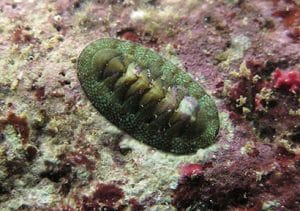
The polyplacophora are an abundant and important aspect of the sea floor. They can be found from the intertidal zone to deep waters. Leptochiton vitjazae has been found at a depth of 7,657 meters. However most species are either intertidal or sublittoral (the area nearest the shore but not exposed by tidal changes in water depth).
Leptochiton vitjazae is the deepest living chiton so far discovered, it and several other ultra-abyssal species feed on wood.
Some species are known from only a very limited geographic area. For example X is a species that is only know from one locale on the coast of Y. Other species have much wider distribution, Katherina tunicata is found from Kamchatka on the coast of Russia to southern California.
The polypalcophora are an ancient groups of organisms. The oldest true chiton fossils occur in rocks from the cambrian period (541 to 485 MYA). Because of their shells and the hard teeth on their radula the fossil record is pretty good for chitons. About 430 fossil species have been named to date.
Basic Biology of the Polyplacophora
Polyplacophorans are bottom dwelling animals. With over 1,000 species chitons are a diverse and successful class of molluscs. Seen from above they are a flattened, elongated oval shape. They are found on algae and on sandy substrates, but mostly on harder surfaces such as rocks and corals. All chitons lack a real head, have no eyes and no tentacles around the mouth.
Possession of a strong muscular foot allows them to cling tightly to rocky surfaces. This helps them survive the pressure of waves and tides along the sea shore. It is also the reason they are often confused with limpets, which have a similar habit and live in the same environment.
Around the edges of the chiton body can be seen a fringe of organic matter called the girdle. This girdle is actually an extension of the mantle. The mantle covers the top of the animal and secretes the eight shell plates. The shell plates remain flexibly connected to the mantle and are hinged.
The fact that they are separate, yet hinged and flexible, allows the chiton more ability to flex its body. If removed from the substrate it can roll up into a ball, thus protecting its inner body.
The Unique Chiton Shell
The chiton shell plates have four distinct layers. The innermost layer that maintains contact with the mantle is called the ‘hypostracum’. Above this lies the ‘articulamentum’ which is composed of pure calcium carbonate in the form of aragonite.
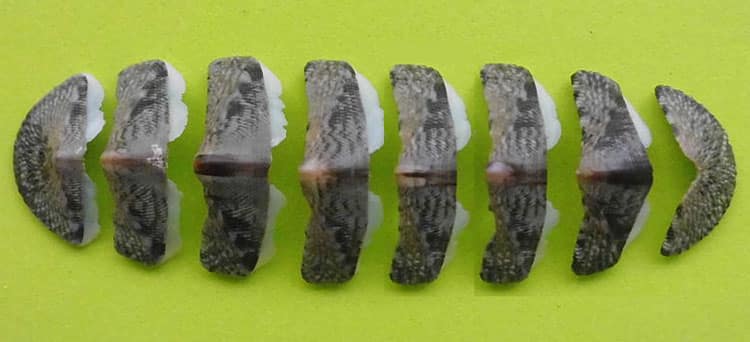
The next outer layer is the ‘tegmentum’ made up of a mixture of calcium carbonate and proteinaceous material known as conchiolin. Finally the outer surface layer is the called the periostracum. The periostracum is organic in structure and sometimes included in the tegmentum as its epidermis.
In some species the girdle is extended to partially, or completely cover the shell plates. Katharina tunicata is a species in which the girdle extends to partially cover the shell plates. Cryptochiton stelleri is an example of a species where the girdle covers the whole of the animal’s back. In this case the girdle also supplies cryptic colouration, the colour of the red algae the species feeds on. The species at the top of the page, Tonicella lineata, has the more usual arrangement of girdle and shell plates.
Chitons are well known for being quite colourful. To my eye many of them are definitely beautiful.
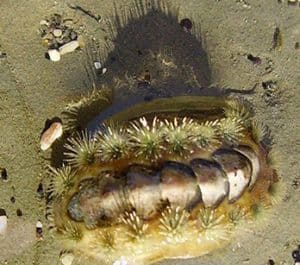
In many species the colour is cryptic and supplied by the girdle and the periostracum. Other species have various additions to their outer surface in the form of numerous calcareous spines, scales, hairs or bristles. These are secreted by the periostracum or the girdle and are usually considered to be ornamental or defensive.
Acanthochitona zelandicais a smallish and attractive species of chiton endemic to New Zealand shows numerous tufts of hair like bristles rising up from its girdle and encircling the animal. Hence its common name of ‘Tufted’, or ‘Hairy Chiton’.
Polyplacophoran Asthetes
The polyplacophora have no eyes. However all known species of chitons possess unusual organs scattered across, and embedded in, their tegmentum. These are typically minute (too small to be seen with the unaided eye), are crystalline and are referred to as aesthetes.
These aesthetes have been suggested to perform a double role for the chitons. They are photo sensitive, and thus act as simple eyes. However being crystalline (aragonite) they can also serve a protective function.
Their photosenstivity allows chitons to detect changes in light above them. If the light is dimmed they can cease feeding and clamp down harder on the substrate, making it more difficult for predators to remove them.
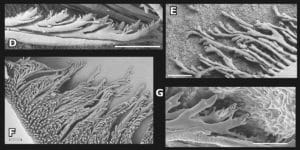
These Asthetes rest in a small bulbous chambers in the tegmentum and connect to the outer dorsal surface of the chiton through pores. The whole network of asthetes is connected by a set of tissue filled cannals. The asthestes are distributed differently and have different densities in different species of polyplacophorans.
The value of the differences in structure of these cannals between species, and higher taxonomic groups, for future classification has been studied by Michael J. Vendrasco et. al.
More Polyplacophoran Anatomy
Polyplacophorans breath by means of ctendia (a sort of gill structure). These ctenidia are located inside the mantle cavity and towards the rear of the animal. They are paired, meaning there is always the same number on each side of the animal’s body.
There is considerable variation between species in the number of ctendia, with some species having as few as six pairs and others as many eighty-eight pairs. In those species with numerous pairs of ctendia, such as Cryptochiton stelleri, they appear to occupy most of the lateral part of the animal’s mantle cavity.
The Mantle
The mantle is a very important part of most molluscan bodies. On the external surface it secretes the shell and other structures such as spines and hairs and in the polyplacophora it also forms the girdle. Internally it protects the softer body organs of the animal.
In most molluscs, there a space between the outer edge of the animal’s foot and the mantle. This space is called the “mantle cavity” or “pallial cavity” or “pallial groove”.
The mantle cavity is an important part of chiton anatomy. It houses the ctenidia (gills), the nephridia (kidneys), the gonopores (reproductive organs) the osphradia (sense organs) and the anus. Because the mantle cavity lies beneath the outer mantle/girdle but is still flushed with clean sea-water, it can also serve as a brood chamber in those species which brood their young.
The Heart and Blood System
The polyplacophoran heart is tripartite with a single ventricle and a pair of lateral auricles. The heart is enclosed inside a pericardial membrane. Oxygenated blood is pumped towards the anterior end of the animal’s body through a single aorta. This aorta has several blood vessels along its length that feed fresh blood into the various haemocoelic sinuses that exist throughout the body.
These sinuses enclose different body organs and are connected, so blood can pass through them. The general flow of blood out of the sinuses is towards the posterior heart. Blood from the single gonad, the pedal sinus and the pedal nerve sinus, passes through the nephridia before reaching the heart via the branchial vein. However blood from the other sinuses; the visceral cavity, the mantle, and the pallial sinus do not pass through the nephridia.
Oxygen is extracted from the sea water by the paired ctendia in the mantle cavity. Water is drawn into the the mantle cavity near the head and flows along both sides of the body (in the mantle cavity) passing over the ctenidia on its way.
This deoxygenated water passes out of the mantle cavity on either side of the anus. The water current is driven through the mantle cavity by the action of cilia.
Like all molluscs, chiton blood and their lymph are mixed together to form haemolymph (US hemolymph). Instead of haemoglobin the mollusc blood system uses haemocyanin, a copper rather than iron based molecule as its active O2 bonding molecule. This results in mollusc blood being blue when it is oxygenated and clear when it is not.
Brain and Nervous System of the Polyplacophora
The polyplacophora nervous system is simple and until recently it was considered that they had no real brain. They do have two sets of paired nerve chords. A ventral pair called the pedal nerve chords that run beneath the digestive organs and a lateral set called the pallial nerve chords. The separate chords in both sets of nerves are cross connected by numerous small nerve strands.
The four nerve chords all meet near the head of the animal, in what is called the cerebral commissure (nerve ring). This in turn is connected to two lateral ganglia called the buccal ganglia. As I mentioned above most textbooks state that chitons do not possess a brain.
However in their recent, and interesting paper, “Do chitons have a brain?” (2018) Lauren Sumner-Rooney and Julia D Sigwart argue that chitons do in fact possess a rudimentary brain by the standards of modern neurology, just that it is not organised in a way we traditionally recognize.

The Digestive System
The mouth of chitons has no tentacles, but does have a veil of muscular tissue derived from the mantle. Like all molluscs the main feed organ is the radula. In chitons there is less variation in radula structure than in other classes of molluscs. Most species have between 13 and 17 teeth per row and from 24 to 150 rows of teeth. Some of these teeth are capped with magnetite (an iron compound that makes the teeth much harder). The radula is used like a scraper, or grater to remove small particles of food.
This food is drawn into the buccal cavity and moved along to the oesophagus by a mucous flow. The oesophagus is short and leads to the rounded stomach, from which it is separated by a muscular sphincter. From the stomach the food moves in the intestines which leads to the posterior anus.
Intestinal length in chitons is variable between species. This variation follows the classical pattern of being shorter in carnivores than in herbivores. Ambush predators and true carnivores like Placivorella velata have a much short intestinal tracts that form a single major loop, whereas obligate herbivores like Katharina tunicata have dramatically long intestinal lengths with multiple coilings. Omnivorous species have gut lengths that are intermediate.
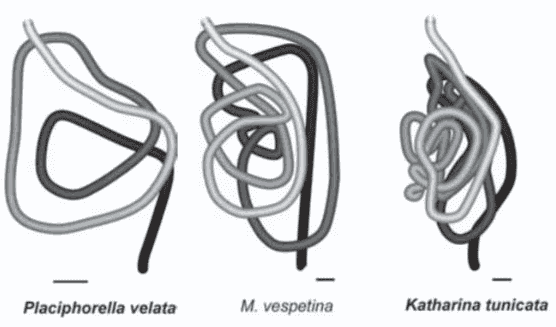
Ecology of Polyplacophora
Some species of chitons are almost completely sessile, for example Nuttalina fluxa a species which lives in small holes in the rocky coasts of California. Many others such as Mopalia muscosa (40 to 55 mm in length), another Californian species, exhibit homing characteristics.
This means the animal has a designated area it rests in during the day or during low tide. It will leave this ‘home’ in the quest for food and then return to it again to rest some more. Believe it or not, these apparently static animals may commute as much 60 cm out and 60 cm back each day.
Feeding Ecology
Chitons exhibit seven different feeding behaviours in terms of what they primarily feed on.
- Omnivorous Grazers – this is perhaps the most common feeding strategy among chitons. Chiton calliozonus
- Herbivores – eat plants, mostly algae = seaweed. Ischnochiton australis
- Detritivores – eat anything that the find on the sea floor.
- Carnivorous Grazers – specialize of sessile animals such as barnacles, bryozoans and corals. Chaetopleura angulata
- Spongivores – specialize on eating sponges. Notoplax speciosa
- Epizoophagus Feeders – Oldroydia percrassa
- Xylophagous Feeders – live on a specialize in eating wood. Nierstraszella lineata
- True Predators – trap or catch small animals to feed on. Loricella angasi
The true predator chitons are sit and wait predators. They lift up the front part of their mantle and when a small organism such as a shrimp attempts to hide, or shelter, under this lip they trap it by bringing the mantle down.
The majority of chitons feed by moving slowly over the substrate and use their radula (toothed tongue) to scrape up edible material. While many species are polyphagous (feed on many species of plant or animal) some such as the giant Gum Boot chiton Cryptochiton stelleri specialize on one type of food source. In the case of the Gumboot chiton this is red algae.
Seaweed (algae) is the most common form of food for herbivores, but some species such as Ischochiton torri feed on sea grasses. Detrivores feed on dead animals, diatoms and bacterial films.

Reproductive Ecology
Most chitons are dioecious, two hermaphroditic species are know to date. Chitons possess only a single gonad which releases ova or sperm through paired gonopores into the mantle cavity. These gonopores are situated forward of the nephridopores. For most species fertilization either takes place in the open water or in the mantle cavity of the female. In some species the eggs are retained and brooded inside the mantle cavity. In other the eggs are released either singly or in groups or strings.
Polyplacophoran eggs have what is called a ‘hull’ rather than a shell. These ‘hulls’ can be smooth on their external surface or decorated with spines, cones, cupules and various other outgrowths. They are actually very attractive and in many cases species specific.
The fertilized eggs develop into trochophore larvae. In non-brooding species these have a short, free swimming life before transforming into young chitons. In those species that brood, such as Ischnochiton mayi, the trochophore larvae either remain in the female’s mantle cavity until they turn into young chitons, or depart to join the ocean’s zooplankton.
What Feeds on Chitons
Chitons are fed on by a variety of other animals including human beings (see below). Other Molluscs such as carnivorous whelks (Gastropoda) and Octopi (Cephalopoda) will also eat chitons, as do other predatory invertebrates such as crabs, sea stars and starfish. Apart from humans, the vertebrates most known for eating chitons are fish and birds. Among birds, gulls and oystercatchers in particular can consume large number of chitons.
The Polyplacophora and Humanity
The Python Chiton (Chiton salihafui) is a medium-sized member of the polyplacophora from the west coast of Africa – where it is collected to be used in local traditional medicine.
Chitons were regularly eaten by the Tlingit and Nootka peoples of Western North America. In fact, even today chitons are part of the diet of some people on various Caribbean islands, in the Philippines and even on some South Korean islands.
Image Credits: Article Cover Image by Kirt L. Onthank, Separated Shell by Veronidae, – License CC BY-SA 3.0 Chiton mauritianus by Philippe Bourjon CC BY-SA 4.0, Wiki Commons;

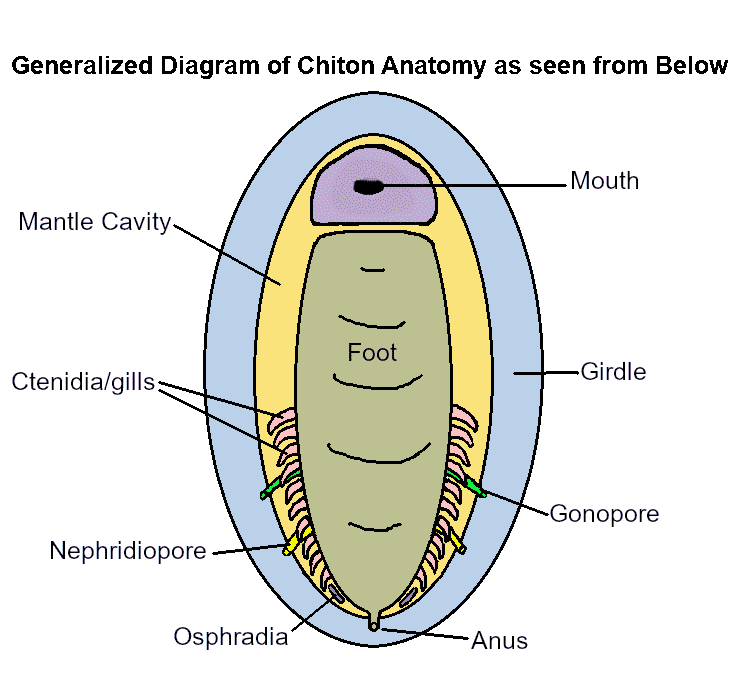
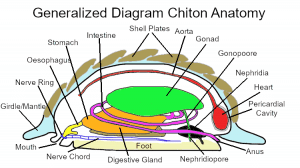
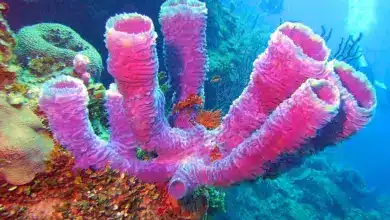

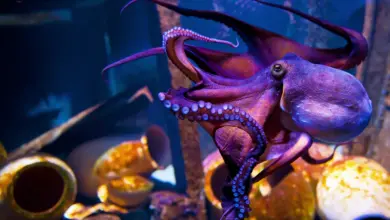
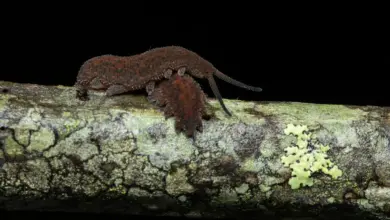
Hello, are you aware of older versions of this critter who only have 5 sections? Small, about 1 mm. I have several from some quartzite I took from the Potomac river, in Frederick, Md. I have a zoom scope that only goes to 45 power, but they do not appear to have any fuzzy outside edge. The sections go all the way to the edge. I can not send good pictures, but would send the rocks if you were interested, but I would want them back, eventually. Thanks, in hope I don’t sound too crazy. Dan
Hi Daniel, Earthlife is a kind of textbook, it is not a research institute (sadly) nor is it affiliated with any university, it is strictly a one-man-job, and that man also has a full-time teaching job to pay the bills, so thanks for the offer, but keep your fossils, and maybe show them to you local Natural History Museum.
A Question on the number of shells for a chiton. I live now in Santa Cruz, but lived in S. CA. growing up. I have sporadic chiton shells, some quite beutiful and only 1 full set of 8 I was lucky enough to come upon at some time. I won’t kill live animals. A few weeks ago on the coast between Santa Cruz and San Francisco I found a gumboot chiton on the beach at low tide. I reached to it, ready to return it to the ocean. It was already dead so I brought it home. After gross machinations you don’t want to hear about, I got the shells. But only 7 of them! I notice in your photo above you also have only 7 shells. Do you have any futher info on the 7 shell phenomenon? Many thanks, Julie
Well that was a surprise. Thanks a load for your comment Julie, especially for pointing out the missing plate, which you will see I have fixed. I did not make the image myself but simple found it on Wiki Commons. To answer your questions; yours is the first reference I have had, and the only one I can find, to a chiton with only seven plates. Eight is the default value, which is why I have updated the image.